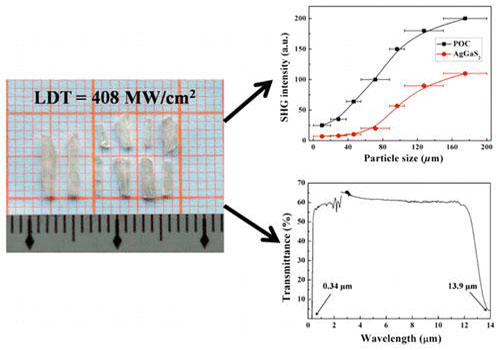Nonlinear optical (NLO) materials, which can expand the wavelength range provided by common laser sources through second harmonic generation (SHG), have been at the forefront of laser science and technology. However, two main drawbacks weigh seriously against the applications of the commercially available infrared (IR) NLO crystals (e.g., AgGaQ2 (Q = S, Se) and ZnGeP2), including low laser damage threshold (LDT) and difficulty to grow high-quality crystals. To search for new IR NLO crystals with both high LDT and moderate SHG response that can also be easily grown is still a challenge.
A research group led by Prof. PAN Shilie at Xinjiang Technical Institute of Physics & Chemistry of Chinese Academy of Sciences with American scientists from Northwestern University developed a promising IR NLO crystal, Pb17O8Cl18 (POC). Both polycrystalline samples and single crystals of POC synthesized in an open system.
Researchers introduced the Cl– anion with a large electronegativity and Pb2+ as a relatively heavy element in POC which gave rise to the extension of its UV and IR cutoff edges to 0.34 and 13.9 μm. Besides, Chlorine could increase the band gap and obtain higher laser damage threshold, and SHG response was enhanced by introduction of lone-pair cations Pb2+. POC was thermally stable up to about 550 °C, which was quite high among halide-based IR NLO materials.
The SHG properties of the PbCl2–PbO system proposed for the first time.The crystal structure of POC consists of only the targeted Pb–O and Pb–Cl bonds, which are beneficial for enlarging its IR and UV cutoff edges, respectively. POC crystallizes in the space group Fmm2 (No. 42) of the orthorhombic system with the unit cell parameters a = 35.4963(14) Å, b = 5.8320(2) Å, c = 16.0912(6) Å, V = 3331.1(2) Å3, and Z = 3. The structure was solved with the SHELXL program package and refined to R1 = 0.0557 for 1729 reflections with Fo> 4σ(Fo) and wR2 = 0.1321.
Researchers found that POC could effectively overcome the two main drawbacks of the commercially available IR NLO materials, and it showed high LDT of 408 MW/cm2, which is 12.8 times that of the benchmark IR NLO AgGaS2 materials. They obtained transparent POC single crystals with 7 mm × 2 mm × 2 mm in air. The POC overcame the difficulty to grow high-quality crystals by the conventional Bridgman−Stockbarger technique.
The result was published as a communication in J. Am. Chem. Soc..
This work was financially supported by the National Natural Science Foundation of China, the Western Light of Chinese Academy of Sciences, 973 Program of China, etc.

Figure: Photograph of as grown crystal in an open system and the linear and nonlinear optical properties of Pb17O8Cl18. (Image by XTIPC)
Contact:
Prof. PAN Shilie
E-mail:slpan@ms.xjb.ac.cn
Xinjiang Technical Institute of Physics & Chemistry,CAS
